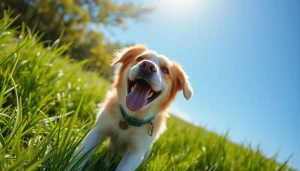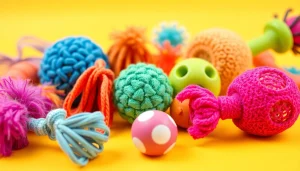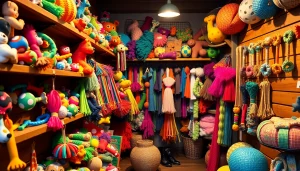Top 10 Canine Toys to Keep Your Dog Happy and Engaged

Understanding the Importance of Canine Toys
Canine toys play a vital role in the healthy development and happiness of our furry friends. These seemingly simple items provide more than just amusement; they serve essential functions for your dog’s physical and mental well-being. Choosing the right canine toys can significantly impact your dog’s health, behavior, and overall quality of life. In this section, we’ll delve into the myriad benefits dogs gain from having access to suitable toys.
Benefits for Physical Health
Regular play with appropriate canine toys is essential for maintaining a dog’s physical health. Engaging in active play helps dogs to stay fit and reduces the risk of obesity, which is becoming increasingly common among domestic dogs. Chew toys, fetch toys, and interactive toys encourage physical activity, which is essential for building strong muscles and keeping joints healthy. Additionally, toys designed for chewing can promote dental health by helping to reduce plaque and tartar buildup, contributing to fresher breath and healthier gums.
Enhancing Mental Stimulation
Canine toys serve as valuable instruments for mental stimulation. Dogs are intelligent creatures that require regular mental challenges to avoid boredom, which can lead to destructive behaviors. Toys that encourage problem-solving—such as puzzle feeders and interactive toys—can help sharpen your dog’s cognitive skills. Engaging your dog’s mind can lead to improved behavior and reduced anxiety, as mentally stimulated dogs are usually calmer and more focused.
Strengthening the Human-Canine Bond
Playing with your dog is an excellent way to strengthen your bond. Interactive toys that involve both you and your dog—like tug toys—encourage shared experiences that enhance companionship. Regular play sessions can reinforce good behavior and improve your dog’s obedience. Moreover, the emotional connection cultivated during playtime serves to deepen the trust between you and your furry friend, creating a harmonious living environment.
Types of Canine Toys: A Comprehensive Guide
The market is flooded with various types of canine toys, each designed to serve different purposes. Understanding the various categories can help pet owners make informed choices for their canine companions. Here, we categorize these toys and discuss their specific features and benefits.
Chew Toys: Durable Choices for Aggressive Chewers
Chew toys are specifically designed for dogs who have a natural tendency to chew. They are typically made from strong materials that can withstand the vigorous chewing of aggressive dogs. Durable rubber or nylon chew toys can not only entertain your dogs but also cater to their instinctual needs. These toys are especially important for puppies, who are teething and need something to chew on to alleviate discomfort. Furthermore, chew toys can aid in cleaning teeth and promoting oral health.
Interactive Toys: Fun and Engaging Playtime
Interactive toys take playtime to a whole new level by encouraging your dog to think and engage. These toys often require a level of problem-solving to achieve a reward, such as treats being dispensed when the dog interacts with the toy correctly. Examples include treat-dispensing puzzles or toys with hidden compartments. Such toys are excellent for keeping your dog mentally stimulated and preventing boredom, especially during your absence.
Fetch Toys: Promoting Active Lifestyle
Fetch toys are quintessential for promoting an active lifestyle, encouraging dogs to run and play. Balls, frisbees, and other throwables are perfect examples of fetch toys. Playing fetch not only provides physical exercise but also enhances coordination and agility. It’s an activity that many dogs instinctively enjoy, making it a great way to bond while ensuring they get their required exercise. Incorporating fetch into your daily routine can improve your dog’s overall physical health.
How to Choose the Right Canine Toys for Your Dog
Selecting the right toys involves considering several factors, including your dog’s size, breed, activity level, and play style. This personalized approach will ensure that the toys you choose provide the maximum benefit and enjoyment for your canine companion.
Consider Your Dog’s Size and Breed
Size matters significantly when selecting canine toys. Small toys can pose a choking hazard for larger breeds, while oversized toys may be difficult for smaller dogs to handle. Consider your dog’s breed and size when shopping. For instance, terriers might benefit from smaller, more intricate toys that challenge their curiosity, while large breeds like Great Danes require sturdier toys that can withstand their strength. Always choose toys that are appropriately sized for your dog.
Assessing Activity Level and Play Style
Your dog’s personality and activity level significantly influence their toy preferences. Energetic dogs may thrive on high-paced interactive toys, while more laid-back canine companions might prefer soft plush toys or chew toys. Observing how your dog plays can provide valuable insight into what types of toys will best suit them. Dogs with high prey drives, such as working breeds, may prefer toys that mimic prey behavior, like wobbly balls or tug ropes.
Tailoring your selection to your dog’s individual play style will enhance their playtime experience and keep them engaged for longer periods.
Safety Features: What to Look For
Safety should always be a priority when selecting canine toys. Look for toys made from non-toxic materials that are designed to withstand chewing without breaking apart easily. Avoid toys with small parts that could create choking hazards. It’s also essential to check for any visible signs of wear and tear regularly. Durable, well-constructed toys often provide the best combination of safety and durability, ensuring that playtime can continue without incident.
DIY Canine Toys: Creative Ideas for Budget-Conscious Owners
Not every toy needs to be store-bought. In fact, creating DIY toys can be a fun and rewarding experience for both you and your dog. Here are several creative ideas for those interested in making their own canine toys, perfect for budget-conscious owners.
Using Household Items for Playtime
Look no further than your home for materials to create engaging and safe canine toys. Common items such as old t-shirts can be braided into ropes for tug-of-war games. Empty plastic bottles can be turned into squeaky toys by inserting and securing them in fabric. Always supervise your dog during playtime with DIY toys to ensure their safety, as you want to avoid sharp edges or small parts that could be released.
Crafting Fun Toys from Recycled Materials
Recycling materials not only protects the environment but also provides an excellent way to create fun toys for your dog. Consider making a tug ball from old jeans filled with other fabric scraps or an old tennis ball with a slit placed in it to hide treats. The creation process can be an enjoyable project, and using recycled materials helps reduce waste while giving your pet something to enjoy.
Fun Recipes for Edible Treat Toys
Edible treat toys combine playtime and snack time seamlessly! You can create a simple DIY treat toy by freezing your dog’s favorite liquid in a durable mold. For example, mixing water with healthy ingredients like chicken broth or adding fruit can make for a refreshing summer treat. Moreover, several recipes are designed to fit into hollow toys, transforming them into dispensers that keep your dog entertained while rewarding them with delicious snacks.
Maintaining and Caring for Canine Toys
Once you have chosen the perfect canine toys for your dog, understanding how to maintain and care for them will ensure they last longer and remain safe for use. Here is how to keep your dog’s toys in top condition.
Cleaning Techniques for Different Materials
Different toy materials require various cleaning methods. Rubber and silicone toys can often be washed in the dishwasher or through hand washing with warm soapy water. Fabric toys may require machine washing, while plush toys can simply be spot cleaned. Always make sure that toys dry completely to prevent mold and bacteria buildup. Regular cleaning of your dog’s toys can significantly reduce the spread of germs and help maintain your dog’s health.
When to Replace Worn-Out Toys
Knowing when to replace your dog’s toys is vital for their safety. Check for signs of wear such as loose seams, stuffing coming out, or any sharp edges. Worn-out toys can pose choking hazards or injure your dog. Typically, rubber toys can last longer than soft fabric toys, which may require more frequent replacements depending on your dog’s chewing habits and play style. Establish a regular inspection routine to ensure that only safe, intact toys are provided for your dog.
Maximizing Lifespan with Safe Storage
Proper storage of canine toys can extend their lifespan and keep your home organized. Store toys in a designated bin or bag to prevent them from getting lost or damaged. After playtime, take time to clean and store away toys to prevent dirt and dust accumulation. This not only keeps your home tidy but also ensures that toys are ready for the next exciting play session. Rotating toys periodically can also help sustain your dog’s interest and prolong the lifespan of each toy.







